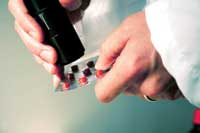Keeping It Real
Counterfeiting and other forms of adulteration periodically strike dietary supplements, just as they do pharmaceuticals. In February, a Roanoke Rapids, NC, newspaper reported that police had arrested a man found transporting counterfeit Centrum vitamins.
Originally Published NO June 2010

Counterfeiting and other forms of adulteration periodically strike dietary supplements, just as they do pharmaceuticals. In February, a Roanoke Rapids, NC, newspaper reported that police had arrested a man found transporting counterfeit Centrum vitamins. Later, in March, two individuals, one in Hawaii and one in Plano, TX, were arrested for illegally trafficking counterfeit weight-loss supplements. To avoid tampering, product security is employed, often on packaging in the form of universal product codes (UPC) or radio-frequency identification. Now, a Hawaii firm has developed technology that takes product authentication a step further-by incorporating edible security tags directly in a dietary supplement itself.
TruTag technology was introduced by Cellular Bioengineering Inc. (CBI) three years ago and is starting to come to market now. The "microtags" are porous silica wafers containing a "spectral barcode" that can be read by a portable spectrometer-based optical reader. The coding on a TruTag doesn't lie on the tag's surface; rather, it is present throughout the tag. CBI points out that, unlike UPC codes, which must remain intact to be read, a TruTag can be broken into small pieces and still work. (A typical tag size is 75 µm, approximately the width of a human hair.)
FDA considers silica, TruTag's material, generally recognized as safe (GRAS). Thus, TruTag can be used in a range of foods as well. (CPI says that as a GRAS ingredient, FDA allows silica to be used at a limit of up to 2% by weight. TruTags are added in amounts much smaller than that, in the range of 0.01% by weight.)
TruTag is also designed to withstand the rigors of food and supplement production. The tags are manufactured without additives or markers and are chemically inert so as not to interact or interfere with other ingredients. They are also moisture-resistant, melt-resistant to temperatures below 1600°C, can be refrigerated, and can withstand pressure exerted during tablet compression.
The technology can be applied to a capsule's coating or can be mixed throughout-for instance, in the excipient. One caveat-in order to be scanned for verification, the product must be visible. Thus, in order to be read through unopened packaging, a TruTag-infused supplement would need to be housed in a transparent package such as a blister pack, instead of, for instance, an opaque vitamin bottle.
That aside, TruTags could be verified at any point during distribution. "They have the capability of ultimately being used anywhere in the supply chain, from raw ingredients to retail," says Mike O'Neill, TruTag Technologies' CTO. He says that a major U.S. nutraceuticals company is currently conducting trials for various applications, including clear and opaque coatings.
"This pilot partner was able to apply our tags to their tablets without any change to their existing manufacturing process and without any impact to the look or feel of the coatings," says O'Neill. As an example, he says that the tags can be added using existing industry-standard pan coaters to the outside of a tablet.
He points out another cost saver: a mature silicon wafer industry that makes it possible to produce the low-cost tags. "Elemental silicon is converted to 100% silicone dioxide, also known as silica, simply by heating." Also, the tags can be created in random shapes-another cost saver.
This small-sized technology shows big promise. Frost & Sullivan gave TruTag its 2010 North American Pharmaceutical and Biotechnology Technology Innovation of the Year award.
"Most authentication formats used today are packaging-oriented," says O'Neill. "On-dose authentication is a relatively new and emerging market that has been developing quietly in the background." Last July, FDA gave a nod to this trend by releasing draft guidance on direct-product tagging, stating that only safe, well-studied food additives should be used.
"There is clearly an industry need for on-dose authentication, because the counterfeiters have figured out how to beat current packaging-level security systems," says O'Neill.
The Nutritional Outlook Podcast Episode 39: Nutritional Outlook's Ingredients to Watch in 2025
February 25th 2025In this episode, Nutritional Outlook interviews Scott Dicker, market insights director from market researcher SPINS, about ingredients and product categories nutraceutical and nutrition product manufacturers should watch in 2025.










